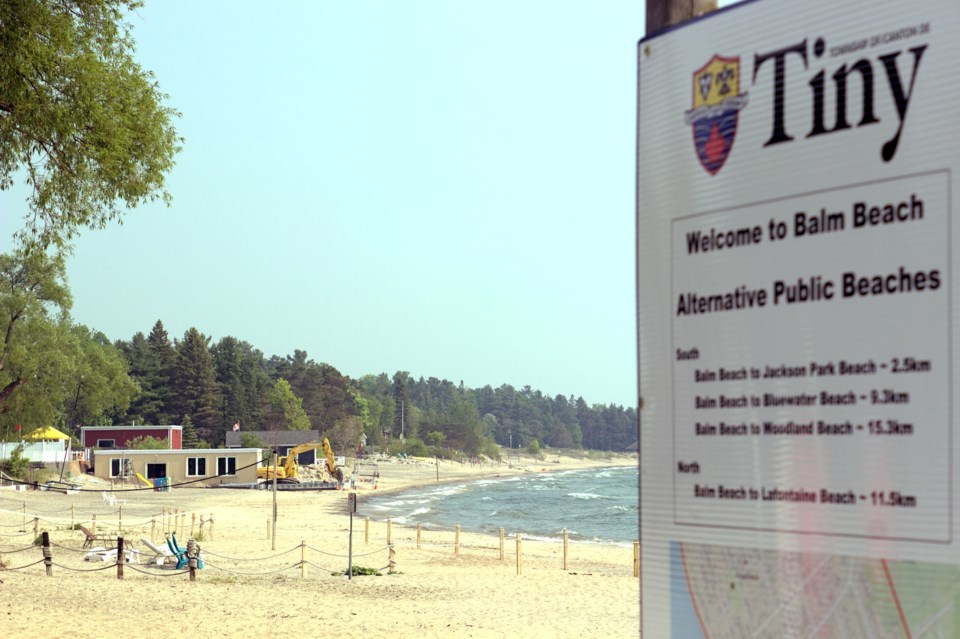One year after a rare interim control bylaw blanketed Tiny Township in an attempt to halt beach development, council made a decision to extend the stopgap measure with hopes the matter would be resolved before its two-year end date.
Construction impacting the dynamic beach and shoreline of the Georgian Bay township prompted Tiny council to scramble for a way to pacify residents, protect the environment, while still allowing for development and growth. At the height of contention, a rarely-used municipal tool known as an interim control bylaw was established last May to fully stop development along the beach.
The primary goals for council were to explore the environmental and legal aspects of dynamic beaches for Tiny; to find shoreline definitions within the 70-kilometres of coastline, while also protecting the township from potential litigation once a formal bylaw could be established.
At a recent special council meeting, council and residents received an update from professional engineer Judy Sullivan, president of Aqua Solutions 5 Inc. (AQS5) on the report findings. Sullivan stated that the challenge was to find the balance between development and protection.
“In this township, you do have these beautiful natural features that haven’t been totally destroyed yet – which is not always the case in the GTA and all these other areas,” said Sullivan. “You have an opportunity to look at saving that natural resource, which in itself is providing protection for development behind it.”
After establishing that the provincial guidelines would protect natural hazard management of shoreline hazards – flooding, erosion, and dynamic beach hazards – through the Provincial Policy Statement, Sullivan was able to explain that the township contained roughly 50 percent dynamic beach, 40 per cent potential dynamic beach and 10 per cent non-dynamic beach.
According to the report, a dynamic beach was defined as: “A shoreline with areas of inherently unstable accumulations of shoreline sediment/sand or dune landward of the water line. It has a beach area greater than 0.3 meters deep, 10 meters wide and 100 meters long. The beach is exposed to wave action that can alter the beach profile.”
Concerns raised by residents from the construction and planning communities were in regards to the non-dynamic portion, which Sullivan addressed as still being protected.
“Some of the areas (at roughly) 10 per cent are not dynamic beaches; those still have (to abide by) the flood hazard or erosion hazard (criteria),” stated Sullivan. “There isn’t ‘no hazard’ in the non-dynamic beach area.”
Slides presenting the various hazards were provided in the council chambers from the report. Including the 100-year flood level (also called the 178-metre contour), the flood hazard consisted of an additional flood allowance of either 15-metres or determined distance via engineering study. Also, an extra 30 metres to that would be considered a dynamic beach allowance in mainland limits.
Sullivan added that residents with no intentions of developing dynamic beaches could save money simply by following criteria laid out by the province.
“So people are aware: they do not have to do an individual study if they just abide by that setback; that’s why that was developed that way from a provincial standard. They were assuming everybody doesn’t have money to do individual studies, so here is the criteria. You just have to find your 100-year water level and then go back.”
Provincial changes, such as those through the planning and development focused Bill 23, were constantly being monitored, according to Sullivan.
Another concern from construction and planning residents was that little review with consultants would be engaged prior to a draft bylaw which Sullivan refuted, praising the importance of locals living along those beaches as a crucial source of information.
Given the advice that each beach property be dealt with on a case-by-case basis while the interim control bylaw and dynamic beach study continue, Mayor Dave Evans reminded the public that the bylaw was put in place as a “sledgehammer” approach to blanketing the township, but further refinements would come in due time as details were clarified.
Township planning consultant Jamie Robinson of MHBC Planning added that the 2023 interim control bylaw was a pause button to complete the required studies, but the studies hadn’t been completed yet, which was why a request was made for an extension at the special council meeting.
Mayor Dave Evans spoke to MidlandToday following the meeting, sharing that the presentation had educated him to the differentiation between shorelines, “and the recognition that we’ll treat each one in their own unique way – the interplay and relationship between nature and development, and how we need to give Mother Nature the tools to do her job and at the same time protect our investments.”
Evans called the implementation of the interim control bylaw extreme and unfortunate, but supported the decision as “the township’s never had any ability to control anything on the shoreline, ever… there are conditions where people are going to harm that (dynamic shoreline), and that’s why I mentioned tonight asking about irreparable damage to our shoreline.”
Deputy Mayor Sean Miskimins was also asked what he had learned.
“If anything, today’s presentation reaffirms, within scientific context, what we all knew visually; having lived and experienced it, but never being able to articulate it through facts and science,” said Miskimins.
“I think there’s a lot of people that still want to be able to build as close to the water as they can, and right-or-wrong,” said Miskimins, “with it comes inherent risk. At the end of the day, our job as council is to protect this township from litigation. If we’ve got rules in place that protect the public, that protect these homeowners, then it’s all for a good thing.”
The dynamic beach management report by Aqua Solutions 5 Inc. and report on extension to the interim control bylaw can be viewed on the agenda page on the Township of Tiny website.
Archives of council meetings are available to view on the township’s YouTube channel.
